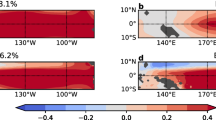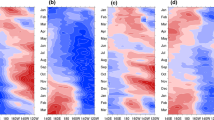Abstract
The El Niño-Southern Oscillation (ENSO) phenomenon affects the global climate by changing temperature and precipitation patterns mainly in tropical climatic regions and median latitudes. Such event strongly influences agricultural activities and crop yields. The Niño Oceanic Index (ONI) of the US National Oceanic and Atmospheric Administration (NOAA) describes and monitors ENSO intensity from ocean temperature measurements. When ONI in the Niño 3.4 region was + 0.5 °C above normal or − 0.5 °C below normal for 5 consecutive 3-month running averages, El Niño (EN) or La Niña (LN) events, respectively, were established. The prediction of ENSO events is made by modeling at major global weather centers by atmosphere–ocean coupling models; however, no articles were found using decision tree classifier (DTC) for ENSO forecasting purposes. This modeling approach requires much less computational time and capacity. Furthermore, DTC can be sufficiently accurate for agricultural purposes. Thus, the objective of this research was to forecast as early as possible the El Niño and La Niña yearly events using a DTC technique from ONI data from 1950 to 2020. We used as input variables for DTC quarterly ONI values from 15 quarters prior the data of forecasting. The DTC showed an accuracy of 89%, 84%, and 78% to predict La Niña, El Niño, and neutral years, respectively, without training period. For validation, the accuracy was 100%, 79%, and 79% for La Niña, El Niño, and neutral years, respectively. The selected ONI quarters were July–August-September, January–February-March, and February–March-April of the previous year and January–February-March of the current year, allowing an 8-month advance forecast with an average accuracy of 78% (validation).

source NOAA) (the colors represent the ocean temperature, the redder the hotter). B Location of the region called Niño 3.4 where the temperature sensors are located to estimate the Niño Ocean Index (ONI)



source NOAA). A year is classified as La Niña when the ONI ≤ − 0.5 and El Niño when the ONI ≥ + 0.5, for 5 consecutive 3-month running averages. The vertical bars indicate the standard deviation of quarterly ONI per year

source NOAA). A quarter is classified as La Niña when the ONI of that period ≤ − 0.5. When the quarterly ONI value ≥ 0.5, the quarter is classified as El Niño. Neutral quarters occur when − 0.5 ≤ average ONI ≤ 0.5. The vertical bars indicate the standard deviation of ONI per year. The letters indicate the quarter, for example, DJF, December, January, and February; JFM, January, February, and March, following this way




Similar content being viewed by others
Data availability
The data/ material is opened.
Code availability
The software used was python, and scripts are available.
References
Alexander MA, Blade I, Newman M, Lanzante JR, Lau N-C, Scott JD (2002) The atmospheric bridge: the influence of ENSO teleconnections on air-sea interaction over the global oceans. J Climate 15:2205–2231
Aparecido LEO, Meneses KC, Rolim G, de Souza MJN, Carvalho WBS Pereira, Santos PA, Moraes TS, da Silva JRSC (2021) Algorithms for forecastingcotton yield based on climatic parameters in Brazil. Arch Agron Soil Sci 18:365–340. https://doi.org/10.1080/03650340.2020.1864821
Armstrong JS, Collopy F, Yokum JT (2005) Decomposition by causal forces: a procedure for forecasting complex time series. Int J Forecasting 21:25–36
Arsanjani R, Dey D, Khachatryan T, Shalev A, Hayes SW, Fish M (2014) Prediction of revascularization after myocardial perfusion SPECT by machine learning in a large population. J Nucl Cardiol 22(5):877–884
Austin PC, Tu JV, Ho JE, Levy D, Lee DS (2013) Using methods from the data-mining and machine-learning literature for disease classification and prediction: a case study examining classification of heart failure subtypes. J Clin Epidemiol 66(4):398–407
Balmaseda MA, Davey MK, Anderson DLT (1995) Decadal and seasonal dependence of ENSO prediction skill. J Climate 8:2705–2715
Barsegyan AA, Kupriyanov MS, Stepanenko VV, Kholod II (2007) Data analysis technologies. Data mining, visual mining, text mining, OLAP. SPb.: BHV-Petersburg, 384 p.
Bastianin A, Lanza A, Manera M (2018) Economic impacts of El Niño southern oscillation: evidence from the Colombian coffee market. Agric Econ 1:3–17
Berlato MA, Farenzena H, Fontana DC (2005) Associação entre El Niño Oscilação Sul e a produtividade do milho no Estado do Rio Grande do Sul. Pesq Agrop Brasileira 40(5):423–432
Breiman L, Friedman J, Stone CJ, Olshen RA (1984) Classification and Regression Trees. Taylor & Francis, The Wadsworth and Brooks-Cole statistics-probability series, p 369p
Chandra A, Mitra P, Dubey SK, Ray SS (2019) Machine learning approach for Kharif rice yield prediction integrating multi-temporal vegetation indices and weather and non-weather variables. ISPRS-Int Arch Photogramm Remote Sens Spat Inf Sci 423:187–194
Chen D, Zebiak SE, Busalacchi AJ, Cane MA (1995) An improved procedure for El Niño forecasting: implications for predictability. Science 269:1699–1702
Chen D, Cane MA, Kaplan A, Zebiak SE, Huang D (2004) Predictability of El Niño over the past 148 years. Nature 428(6984):733
Chimeli A, Souza Filho F, Holanda M, Petterini F (2008) Forecasting the impacts of climate variability: lessons from the rainfed corn market in Ceará. Brazil Environ Dev Econ 13(2):201–227
Clarke AJ (2008) An Introduction to the Dynamics of El Nino and the Southern Oscillation. Elsevier Academic Press, Londres
Climate Prediction Center – CPC (2012) Frequently asked questions about El Niño and La Niña. Disponível em: https://www.cpc.ncep.noaa.gov/products/analysis_monitoring/ensostuff/ensofaq.shtml#forecasts. Accessed 11 Jun 2021
Coimbra R, Rodriguez-Galiano V, Olóriz F, Chica-Olmo M (2014) Regression trees for modeling geochemical data - an application to Late Jurassic carbonates (Ammonitico Rosso). Comput Geosci 73:198–207
Death G, Fabricius KE (2000) Classification and regression trees: a powerful yet simple technique for ecological data analysis. Ecol 81:3178–3192
Gavrilov A, Seleznev A, Mukhin D, Loskutov E, Feigin A, Kurths J (2019) Linear dynamical modes as new variables for data-driven ENSO forecast. Clim Dyn 52(3–4):2199–2216
Goswami BN, Sukla J (1991) Predictability of a coupled ocean-atmosphere model. J Climate 4:3–22
Ham YG, Kim JH, Luo J-J (2019) Deep learning for multi-year ENSO forecasts. Nature 573:568–572
Han J, Kamber M (2011) Data Mining: Concepts and Techniques. Morgan Kaufmann, San Francisco, p 744
Hothorn T, Leisch F, Zeileis A (2005) The design and analysis of benchmark experimentos. J Comput Graph Stat 14(3):675–699
Jin FF (1997) An equatorial ocean recharge paradigm for ENSO. Part I: conceptual model. J Atmos Sci 54:811–829
Kao H-Y, Yu J-Y (2009) Contrasting eastern-Pacific and central-Pacific types of ENSO. J Clim 22(3):615–632
Kirtman BP, Schopf OS (1998) Decadal variability in ENSO predictability and prediction. J Clim 11:2804–2822
Ludescher J, Gozolchiani A, Bogachev MI, Bunde A, Havlin S, Schellnhuber HJ (2014) Very early warning of next El Niño. Proc Natl Acad Sci 111(6):2064–2066
Luo JJ, Masson S, Behera SK, Yamagata T (2008) Extended ENSO predictions using a fully coupled ocean–atmosphere model. J Clim 21(1):84–93
McPhaden MJ, Zebiak SE, Glantz MH (2006) ENSO as an integrating concept in earth science. Science 314(5806):1740–1745
McPhaden MJ (2003) Tropical Pacific Ocean heat content variations and ENSO persistent barriers. Geophys Res Lett 30:1480–1490
Meinen CS, McPhaden MJ (2000) Observations of warm water volume changes in the equatorial Pacific and their relationship to El Niño and La Niña. J Clim 13:3551–3559
Mitchell T (1997) Decision Tree Learning. In: Mitchell T (ed) Machine Learning. The McGraw-Hill Companies Inc, New York, pp 52–78
Monard MC, Baranauskas JA (2003) Indução de Regras e Árvores de Decisão. In: Rezende SO (ed) Sistemas Inteligentes - fundamentos e aplicações. Manole Ltda, Barueri, pp 115–139
NOAA (2017) Cold & warm episodes by season. Online available. https://origin.cpc.ncep.noaa.gov/products/analysis_monitoring/ensostuff/ONI_v5.php. Accessed 19 Jun 2021
Nooteboom PD, Feng QY, Lopez C, Hernandez-García E, Dijkstra A (2018) Using network theory and machine learning to predict El Nino. Earth Syst Dynam 9:969–983
Phillips ND, Neth H, Woike JK, Gaissmaier W (2017) FFTrees: a toolbox to create, visualize, and evaluate fast-and-frugal decision trees. Judgm Decis Mak 12(4):344–368
Pinault JL (2016) Anticipation of ENSO: what teach us the resonantly forced baroclinic waves. Geophy Astrophys Fluid Dyn 110(6):518–528
Quinlan JR (1992) C4.5 Programs for Machine Learning. San Mateo, CA: Morgan Kaufmann
Ronghui H, Yifang W (1989) The influence of ENSO on the summer climate change in China and its mechanism. Adv Atmos Sci 6(1):21–32
Silva TM, Hornberger GM (2019) Identifying El Niño-Southern Oscillation influences on rainfall with classification models: implications for water resource management of Sri Lanka. Hydrol Earth Syst Sci 23(4):1905–1929
Souza Júnior JA, Nechet D, Oliveira MCF, Albuquerque MF (2009) Estudo do comportamento da temperatura e precipitação nos períodos chuvosos e menos chuvosos em Belém-PA em anos de fortes eventos de El Niño e La Niña. Revista Brasileira De Climatologia 5:87–101
Stojanovic M, Apostolovic M, Stojanovic D, Miloševic Z, Toplaovic A, Lakušic VM, Golubovic M (2014) Understanding sensitivity, specificity and predictive values. Vojnosanit Pregl 71(11):1062–1065
Tang Y, Zhang RH, Liu T (2018) Progress in ENSO prediction and predictability study. Natl Sci Rev 5:826–839
Teli A, Amith A, Bhanu Kaushik K, Gopala Krishna Vasanth K, Sowmya BJ, Seema S (2020) Efficient decision support system on agrometeorological data. Adv Intell Syst Comput 940:875–890
Trenberth KE (1997) The definition of El Niño. Bull Amer Met Soc 78:2771–2777
Wei W, Yan Z, Jones PD (2020) A decision-tree approach to seasonal prediction of extreme precipitation in eastern China. Int J Climatol 40(1):255–72
Witten IH, Frank E (2005) Data Mining: Practical Machine Learning Tools and Techniques. Morgan Kaufmann, San Francisco
Zhang M-N, Liu J, Mao K-X, Li Y, Zhang X-H, Shi Y-J (2006) The general distribution characteristics of thermocline of China Sea. Mar Forecast 23(4):51–58
Zhu X, Xu Q, Tang M, Li H, Liu F (2018) A hybrid machine learning and computing model for forecasting displacement of multifactor-induced landslides. Neural Comput Appl 30(12):3825–3835
Funding
This study was financed in part by the Coordenação de Aperfeiçoamento de Pessoal de Nível Superior — Brasil (CAPES) — Finance Code 001.
Author information
Authors and Affiliations
Contributions
KAS: formal analysis, investigation, data curation, writing — original draft, writing — review and editing, and visualization. GdSR: conceptualization, methodology, supervision, and project administration. LEdOA: writing — review and editing.
Corresponding author
Ethics declarations
Ethics approval
It is not necessary.
Consent to participate
Not applicable.
Consent for publication
Not applicable.
Conflict of interest
The authors declare no competing interests.
Additional information
Publisher's note
Springer Nature remains neutral with regard to jurisdictional claims in published maps and institutional affiliations.
Appendices
Appendices
Table 2
Table 3
Rights and permissions
About this article
Cite this article
Silva, K.A., de Souza Rolim, G. & de Oliveira Aparecido, L.E. Forecasting El Niño and La Niña events using decision tree classifier. Theor Appl Climatol 148, 1279–1288 (2022). https://doi.org/10.1007/s00704-022-03999-5
Received:
Accepted:
Published:
Issue Date:
DOI: https://doi.org/10.1007/s00704-022-03999-5




